Coder
Experienced Member
- Joined
- Apr 16, 2023
- Messages
- 84

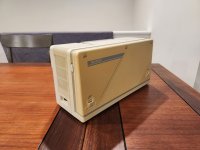
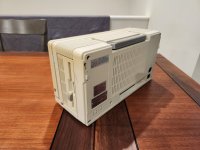
I finally had a much-needed success with my collection of vintage "portables". I bought this Sharp PC-7100 on eBay -- I really need to stay off eBay -- with a bad power supply. The PO said it "blew fuses". After sourcing an appropriate 3.15A 250v fuse and disconnecting everything from the PSU except the PSU's fan, I powered it up and!!! nothing. No blown fuse, but also no signs of life on the low voltage side. Poking around the board, I found that I didn't have continuity between one of the A/C power pins and another pin that was on the same trace. Looking closer, there was a crack right at the A/C in pin. You can just make it out on the photo below. It was completely open! I also found another cracked trace on the other leg of the A/C input. I think the connector had been repeatedly plugged/unplugged and stressed the traces. It's not the most robust connector and relies on the pins to hold it to the board. Once those were repaired, applying power resulted in a low pitch buzz emanating from the area around the two large capacitors. I unplugged the power and made sure the caps were dissipated, then felt the caps. The one I thought the sound was coming from was very hot. Like can't keep your hand on it hot. I suspect it was arching internally as there was no visible arc when it was running. I ordered replacements and once installed, the board started up with no drama and this time the fan kicked on. It's not the healthiest sounding fan, but for now, it's fine. I tested the output of the various low voltage wires and everything looked good. So I hooked up the other components and was greeted with a boot screen! With a disk error! And they keyboard wasn't working! But it was booting! lol
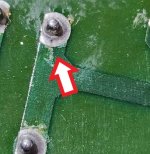
PC-7100's shipped with a Plus+ Hardcard 20; not a drive with a great reputation for reliability, and mine wasn't challenging that notion. Lucky for me, I was raised to have no fear of breaking the broken, so I was happy to poke around it's innards to see if anything shook loose. But, I also knew that many others have come before me, so I took some time to soak up their collective wisdom. It appears that like with many vintage hard drives that have sat for significant periods of time, "stiction" is the main problem. But these also suffer from a degrading rubber bumper that can make a sticky mess, too.
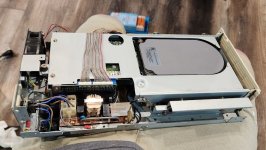
The Plus+ Hardcard 20 is connected to the motherboard via an ISA card slot attached to a ribbon cable. It's my understanding that this ISA slot is non-standard and designed to only work with the Plus+ Hardcard 20, hampering those who's drives can't be revived.
I used the karate chop method to unstick the heads and the drive did spin up after that. But, I was still plagued with a "Disk Error or Drive Not Ready reading Boot Sector!" message. And now there was a fairly unpleasant sound that I now believe was the heads moving back and forth in a rapid and rhythmic fashion, as they tried to seek to the correct position but were unable to.
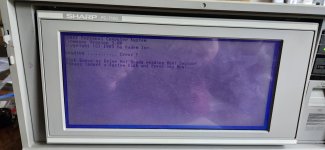
I powered everything off and decided it was time to have a peek inside. A pastry scraper and more-time-than-it-should-have-taken later, I finally got the plastic trim off (That's some stout adhesive!) and I could remove the screws. Lifting the top cover, I saw what appeared to be a fairly standard hard drive. I carefully actuated the head assembly and noted that there was a "tough spot". It felt like two weak opposing magnets pushing away from each other. Not hard for me to easily overcome, but not the bearing-smooth movement I expected, and likely more than the head voice coils could overcome. I remembered a video where someone lubricated this bearing with oil, so I did the same. However, just loosening the screw for the bearing alleviated this tough spot. I think removing the screw just broke the bearing loose. I returned the heads to the parked position and tested the drive with the case open. I know, I know. But it worked! The heads were able to seek over the entire disk surface and initialized properly! The drive booted into DOS and "David's Menu", whoever David is, appeared on the screen. I did some quick poking around to see if the drive was truly reading properly. Everything looked ok and I didn't want to risk running the drive open any longer, so I shut everything down. I inspected the drive further and sure enough, the rubber bumper that softens the head assembly when it reaches it's limits was now a black, sticky, goo. I removed what I'm calling the "limit bumper assembly", which is definitely NOT it's actual name, and removed the goo as best I could with a flat tip screw driver and some isopropyl alcohol. I then wrapped electrical tape around the post until it was roughly the same thickness as the old bumper goo and reassembled the drive. To my relief, it worked and the drive has been reliably booting ever since.
The 5.25 floppy drive got a quick cleaning and lube job and works great, too. That left the keyboard. After figuring out that the rubber bumpers on the bottom just pry out with a flat tip to reveal the screws (there's also two more under the "feet"), the top cover came off to reveal that the keyboard logic PCB had just come loose from the main keyswitch PCB. Plugging that back in brought the keyboard back to life and it works without issues! A quick note for those that may be reading this because they just bought or are thinking of buying one: They keyboard must be plugged in before turning the computer on. If you plug it in afterwards, the computer will not recognize it until you turn it off and on again. That was something I wish I'd known BEFORE I tried to debug my actually-already-working keyboard!
I've been pleasantly surprised by the computer while playing with it. The screen has a very poor reputation with most saying it's hardly readable. That hasn't been my experience, especially if you set the backlight level to "High" in the BIOS. Even on standard, it's pretty easy to read indoors with regular lighting. I wonder if others just have more worn out backlights. I kind of wonder if the power issue took mine out of commission early in life or if it just wasn't used much. These photos are straight off my phone. I didn't edit them except to rotate/crop and add an arrow in the one. The way the screen looks in the photos is exactly how it looks to me, sitting in front of it.
My plans for this computer going forward are to replace the noisy fan, make a backup of the contents of the hard drive, and then maybe install Windows 3.0 for kicks. I might try my hand at retrobriting it eventually, but not until I've had success on lesser machines first. I also want to play around with BASIC programming. I have some ideas of how I can incorporate it into my yearly escape room this Halloween. I think that could be fun.
